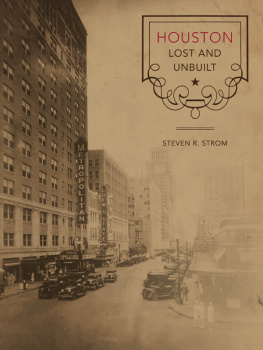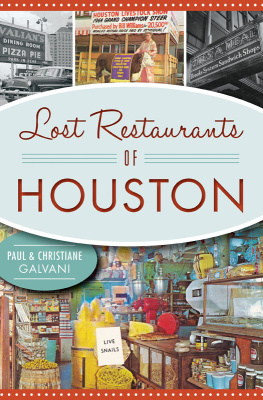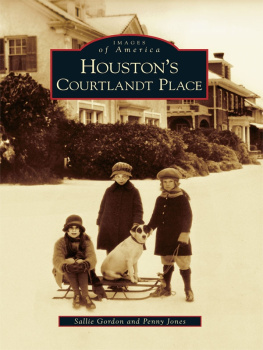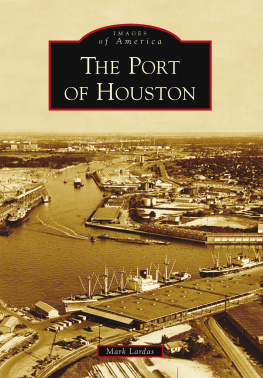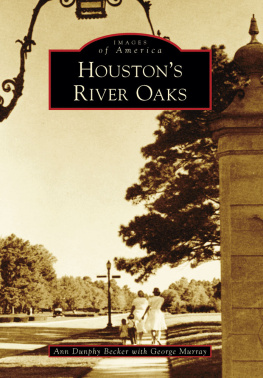Strom - Houston Lost and Unbuilt
Here you can read online Strom - Houston Lost and Unbuilt full text of the book (entire story) in english for free. Download pdf and epub, get meaning, cover and reviews about this ebook. City: Austin;Houston (Tex.);Texas;Houston, year: 2010, publisher: University of Texas Press, genre: Romance novel. Description of the work, (preface) as well as reviews are available. Best literature library LitArk.com created for fans of good reading and offers a wide selection of genres:
Romance novel
Science fiction
Adventure
Detective
Science
History
Home and family
Prose
Art
Politics
Computer
Non-fiction
Religion
Business
Children
Humor
Choose a favorite category and find really read worthwhile books. Enjoy immersion in the world of imagination, feel the emotions of the characters or learn something new for yourself, make an fascinating discovery.
- Book:Houston Lost and Unbuilt
- Author:
- Publisher:University of Texas Press
- Genre:
- Year:2010
- City:Austin;Houston (Tex.);Texas;Houston
- Rating:3 / 5
- Favourites:Add to favourites
- Your mark:
- 60
- 1
- 2
- 3
- 4
- 5
Houston Lost and Unbuilt: summary, description and annotation
We offer to read an annotation, description, summary or preface (depends on what the author of the book "Houston Lost and Unbuilt" wrote himself). If you haven't found the necessary information about the book — write in the comments, we will try to find it.
This fascinating look at what has been lostand what might have been builtin Houston sounds a call to preserve Houstons built heritage before more architectural treasures are lost forever.
Strom: author's other books
Who wrote Houston Lost and Unbuilt? Find out the surname, the name of the author of the book and a list of all author's works by series.
Houston Lost and Unbuilt — read online for free the complete book (whole text) full work
Below is the text of the book, divided by pages. System saving the place of the last page read, allows you to conveniently read the book "Houston Lost and Unbuilt" online for free, without having to search again every time where you left off. Put a bookmark, and you can go to the page where you finished reading at any time.
Font size:
Interval:
Bookmark:
HOUSTON LOST AND UNBUILT

Roger Fullington Series in Architecture
LOST AND
UNBUILT

STEVEN R. STROM

Publication of this book was made possible in part by support from Roger Fullington and a challenge grant from the National Endowment for the Humanities.
Copyright 2010 by the University of Texas Press
All rights reserved
Printed in the United States of America
First edition, 2010
Requests for permission to reproduce material from this work should be sent to:
Permissions
University of Texas Press
P.O. Box 7819
Austin, TX 78713-7819
www.utexas.edu/utpress/about/bpermission.html
 The paper used in this book meets the minimum requirements of ANSI/NISO z39.48-1992 (R1997) (Permanence of Paper).
The paper used in this book meets the minimum requirements of ANSI/NISO z39.48-1992 (R1997) (Permanence of Paper).
Library of Congress Cataloging-in-Publication Data
Strom, Steven.
Houston lost and unbuilt / Steven R. Strom. 1st ed.
p. cm. (Roger Fullington series in architecture)
Includes bibliographical references and index.
ISBN 978-0-292-72113-5 (cloth : alk. paper)
1. Lost architectureTexasHouston. 2. Unbuilt architectural projects TexasHouston. 3. Houston (Tex.)Buildings, structures, etc. I. Title.
NA735.H68s77 2010
720.97641411dc22
2009017503
Institutional E-book ISBN: 978-0-292-79337-8
Individual E-book ISBN: 978-0-292-77352-3
THE INSPIRATION TO write this book resulted from the reactions to the publication of two articles that I wrote for Cite: The Architecture and Design Magazine of Houston. The first article, Lost Houston: Images From a Century of Erasure, appeared in the Fall 1999/Winter 2000 issue of Cite. Shortly after the article appeared, I began to receive responsesfirst e-mails and phone calls and then, unbelievably, handwritten letters. Eventually, several dozen people had contacted me, and almost every single one of them responded with the same basic message: seeing images of Houston buildings that they had known so well in their past, now destroyed and lost forever, had generated an overwhelming, palpable sense of loss. Rather than simply feeling nostalgic, however, many of the readers noted that for the first time they felt true anger at seeing visible proof of the poor job that Houston had done in saving its architectural heritage. Perhaps it was the number of photos and architectural drawings in the article or simply the combination of images that generated such a response... who knows? Nonetheless, these people felt compelled to respond in an age when few have the time to express their thoughts over something as seemingly inconsequential as a magazine article. Clearly something had struck a nerve in the consciousness of these Houstonians.
With the subsequent publication of another article, The Houston that Never Was (Spring 2001), there was again an unexpected number of responses from readers. There is a long-standing tradition in architectural circles to fantasize about buildings that reached the conceptual stage but were never completed. My article pointed out that some purely conceptual Houston projects might be the better for never having been completed in terms of aesthetics and potential negative social and environmental impact. Alternatively, the city was poorer due to its failure to complete other building projects. The people writing and calling about this later article also expressed strong opinions, commenting that it had made them think in new ways about these unbuilt projects. The article made such an impression on architects and preservationists that copies were sometimes handed out on architectural tours, and one professor even made it required reading for one of his architecture classes. As a result of the positive feedback that I received regarding both articles, I decided to increase the number of illustrations of both lost buildings and unbuilt projects and combine them into a single book. In addition, during the course of my research, I realized that the category of lost needed to be expanded to include interiors and store display windows. Fortunately, University of Texas Press ultimately accepted my proposal and the result follows.
I have purposely chosen to concentrate only on civic and commercial structures during the period from the beginning of the twentieth century to the early years of the twenty-first century. Expanding the book to include domestic architecture would have been too massive a project, although this area is certainly worthy of future research. Houstons Forgotten Heritage, published in 1991, covered the citys local domestic architecture so thoroughly up to the beginning of World War I that it deserves a companion piece focusing on the remainder of the twentieth century. Similarly, I did not cover lost structures in the Hispanic community because Dr. Thomas Kreneck documented them so well in his 1989 study Del Pueblo: A Pictorial History of Houstons Hispanic Community. Author David Welling has also done a wonderful job of chronicling Houston movie theaters patronized by Hispanics in Cinema Houston. Despite these omissions, the photos included in the book reveal an architectural toll that is inconceivable. It is my hope that this books audience will be moved to help salvage Houstons remaining historic architecture.
I have provided some background history to accompany the photographs and drawings, but the images are the real stars of this book. None of the captions were ever intended to be in-depth histories of the lost structures or of the architects who built them. However, even if I had wanted the captions to provide more of this information, this task might have proven to be impossible. Despite the volume of information available about Houstons lost architecture, there is still a surprising deficit of original historical resources. The City of Houston did not preserve even the most basic construction and building permit records until the 1970s when some city departments began a semi-concerted effort to do so. The laissez-faire attitude shown by municipal departments toward history was a direct reflection of the almost total disinterest shown by the general populace; only in the past twenty to twenty-five years have Houstonians shown any interest toward historic preservation. The percentage of the citys total population that could be considered preservation activists remains dismally small, but they represent a vocal, organized, well-educated, and increasingly influential minority.
Assembling this book was incredibly fun for me. The photos sometimes presented intriguing cases that called for extensive detective work to unlock the mysteries of Houstons lost past. The observer must scan each photo for visual clues revealing details about its proper placement in time and space. I particularly enjoyed piecing together the visual clues contained in the photograph of the Iris Theatre. The film title on the marquee, Courtin Wildcats, dates the photo to 1929, but further inspection provided clues that allowed me to set a more specific date. First, Christmas lights are strung along the theaters faade. Granted, many entertainment venues used colored lights for decoration in the 1920s, so it was possible that these were not Christmas lights after all. However, one can see that Christmas trees are for sale in the lower left-hand corner of the picture, so the photograph was definitely taken at Christmastime. Second, remains of ice and slush are visible along the curb. According to the National Weather Service, Houston had a fair-sized snowstorm on December 22, 1929. Combining this information with the date of the featured films debut made it possible to date the photo within an accuracy of a few days.
Font size:
Interval:
Bookmark:
Similar books «Houston Lost and Unbuilt»
Look at similar books to Houston Lost and Unbuilt. We have selected literature similar in name and meaning in the hope of providing readers with more options to find new, interesting, not yet read works.
Discussion, reviews of the book Houston Lost and Unbuilt and just readers' own opinions. Leave your comments, write what you think about the work, its meaning or the main characters. Specify what exactly you liked and what you didn't like, and why you think so.

